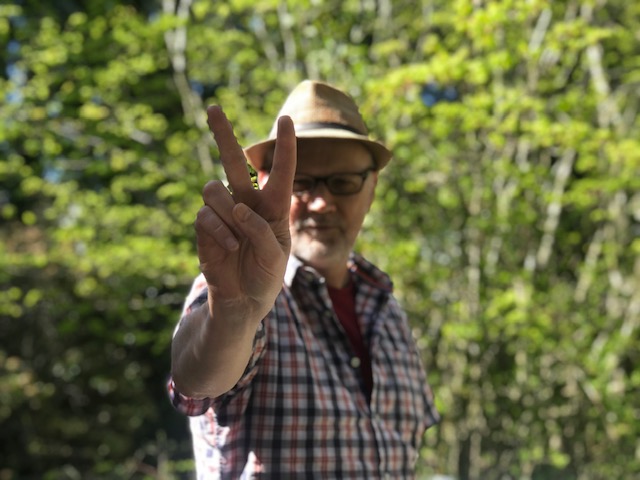V for Vaccine: How we can signal our immunity to each other
From THE GLOBE AND MAIL, May 10, 2021

One recent weekend, the sun came out, prompting locals to spill out onto the forest trails. I joined them, but I found it a little too crowded for comfort out there, given that we’re still at DEFCON 1 with the COVID-19 threat.
As hikers encountered each other on these narrow paths, many of them unmasked, a question mark hung in the air: How safe are we?
On my walk, I reached a pinch-point, with a couple coming toward me. We both stopped. On an impulse, I raised two fingers, palm out, in a V sign. The man nodded, and his wife seemed to exhale – and on they came, still observing their buffer but no longer visibly troubled.
Now, it could be they thought that I was just being friendly – that I was a hippie-chill North Van guy, communicating peace to my brother and sister. But I like to think they understood my intention: to signal, with that “V”, that I had received a vaccine. If I’d been jabbed twice, I’d have made the V with both hands, for double reassurance.
This is a thing. Okay, it’s not yet a thing, but I reckon it could be a thing. If the V-for-vaccinated sign catches on, it could lower our collective blood pressure until we hit herd immunity – not to mention the possibility of forging bonds between strangers at a time when we need the solidarity more than ever.
But how do you get a gesture to become universally adopted?
In 2014, researchers Xiangling Zhuang and Changxu Wu – a psychologist and an engineer – published a study investigating whether hand gestures might make cars more likely to stop for pedestrians at unmarked street crossings. They invented 11 hand signs and tested four of them – including a horizontal point, a crooked-elbow hitch and “time out” T – on street corners in Beijing. They hatched the signs based on sociologist Kurt Lewin’s theory that an effective gesture must have three components: visibility, clarity, and what Dr. Lewin called “motive power” – that it has the intended effect. It turned out that a couple of the gestures proved pretty effective at persuading drivers to stop. But no pedestrian gesture has really caught on. As far as I know, no one, anywhere, just points or flashes a “T” at oncoming cars at street corners. The pedestrian crossing gesture is a high-five left dangling but the culture.
The V-sign, though, is a different story. It has been part of the human repertoire for at least 700 years, though it has meant different things – many of them extremely rude, if you display it backward. Some say the palm-facing V was exchanged by English bowmen in the Battle of Agincourt, in defiance of the French, who had threatened to lop off the shooting fingers of any archer they captured. The V said, effectively: “Ha, varlots! We are still alive and free and full-fingered.”
But it wasn’t until January of 1941 that the V detonated in a whole population. The instigator was a Belgian diplomat named Victor de Laveleye, who proposed it as a rallying symbol for the Allies – V for victoire, in French, or for vrijheid, which means freedom in Dutch. Remember, this was before social media, or even TV, so he couldn’t plant the image in people’s minds. He simply described it on BBC Radio Belgium. But the idea was so lock-in-key perfect for the moment that it took off anyway. The V became iconic when Winston Churchill flashed it on V-day (and perhaps became a little tarnished when Richard Nixon co-opted it a quarter-century later).
That element of urgency may help explain the difference between a meme that goes viral and one that’s stillborn. It could be dictated by whether a society is in the crucible of wartime, or in some random moment when it will be no less safe to cross the street tomorrow. Does a pandemic qualify as urgent?
When I got home, I told my wife, Jen, the story of my impromptu V on the forest path, and about my rosy hopes to launch the very symbol I was proudly showing her right then.
“Wait, when did you get your vaccine?” she asked.
“A week ago.”
“It’s supposed to be two weeks until you’re fully protected.”
I slowly lowered … one of the fingers.
Her face was a mask.
“I think you need to work on your messaging,” she said.